
Our eyes are the windows to the outside world for us. We recognize objects and people through them, aiding in navigating the world. It helps give us an understanding of our standing with respect to our surroundings. We can then take the necessary action that brings us closer to the objective.
The computer world follows the same approach. Cameras operate as their eyes, bringing vital visual data into the system. Artificial Intelligence (A.I.) algorithms then process that data to extract meaningful information about the event being witnessed. But, unlike us, AI doesn’t have ages of evolution behind it to help with image processing. This is where photo annotation comes into the picture.
Annotation is part of the technology of Computer Vision that lets machines interpret digital images and videos. It enables them to gain a high-level understanding of the contents of those images and videos. It also improves Machine Learning (ML) algorithms to do the process by themselves. Thus, the process represents the first step in giving AI the ability to see and understand that data similar to humans.
Read on to learn more about how image annotation services can help you with the development of an AI model that accurately detects, recognizes, and categorizes all that it sees.
Table of Contents
- Image Annotation: What It Is Actually
- The Need For Photo Annotation: High-Quality Training Data
- The Various Types of Image Annotation
- Get The Best Computer Vision Results With Outsourced Image Annotation Services
Image Annotation: What It Is Actually
Computers can be considered to be similar to newborns. They have no concept of the world around them or themselves. Therefore, it is up to developers to program them into developing the required functionalities.
The type of computing we’re familiar with, called Classical computing, requires instructions for every task that it performs. A developer has to manually program those sets of instructions that the computer then uses to process the fed data. The systems use traditional transistor-based circuitry to accomplish their tasks.
Modern-day computing uses this along with something called Artificial Intelligence (AI). AI is a technology that is made to resemble natural or human intelligence. Its main USP is its ability to learn tasks by itself instead of having to program everything.
It uses artificial Neural Network circuitry for the purpose. (Neural because it resembles neurons-the building-block cells in the brain). This “thinking” computer uses what’s called Machine Learning (ML) algorithms to learn its self-computing abilities.
Here’s where image annotation comes in. These AI Models (AI computer programs) need to be “taught” what it is that they are looking at in an image or video. It’s similar to how humans learn about the things they’re seeing by being taught about them.
Professionals manually mark the various objects in images and video data input into the system. Then millions of examples of one or more of the objects are provided to the algorithm. Parsing through so many examples of an object helps the AI become more accurate at recognizing and categorizing that object.
Huge databases of image and video data are maintained for this purpose. Microsoft has the COCO(Common Objects in COntext) image dataset that image annotation services can use. It is open-sourced and has over 2.5 million images of 91 easily recognizable objects. Then there’s ImageNet, a repository of millions of images using the WordNet hierarchy. Both are free to use and keep getting updated regularly.
Developments in ML technology have added automation to the mix here too. Some models only need a few initial annotated examples. ML models can then take over the annotation by themselves. They too get better with practice over time. This process is called model-assisted labeling.
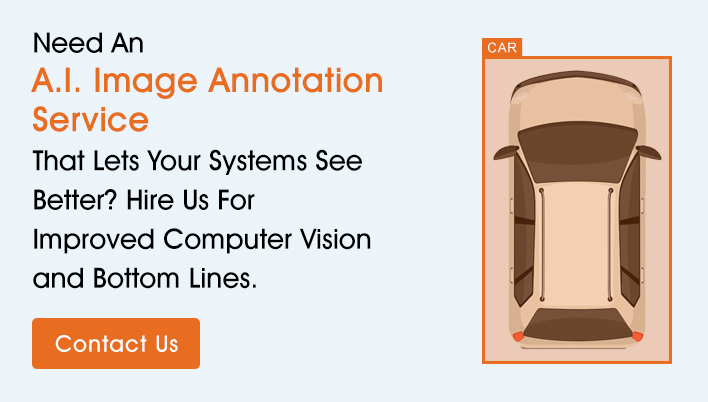
Computer Vision, Machine Learning, and Deep Learning
Venture into the world of photo annotation, and you’re bound to encounter the terms Computer Vision, Machine Learning, and Deep Learning.
If you’re wondering what they mean, here are the details:
Computer Vision
It refers to the technology that enables computers to see the world and understand it similar to humans. It is a subcategory of AI and Deep Learning involving humans training machines in the process. It is meant to help machines use visual data to interpret and comprehend their environment.
It began with understanding how animal brains interpret visual stimuli. Electrodes were used to sample and recreate an image shown to subjects by capturing the neural electric signals. This kickstarted rudimentary AI image annotation with computers.
What began as a recognition of simple lines and shapes has grown into the recognition of complex shapes and objects. Since 2000, Computer vision has been all about Object and Facial recognition. Image Segmentation and Classification are the other areas of focus.
Computer vision works by acquiring the data set via means like a photo, video, or 3D scan models. That data is then labeled and fed into the system. Deep learning algorithms take over after thousands of such examples have given them enough accuracy. The system thus understands that image by interpreting it.
An image annotation service plays a crucial role in providing those labels for the images and videos.
Deep Learning
Deep learning is the technique that enables computers to learn by example. It falls under the broader category of Machine Learning. The difference between the two is that with deep learning, there are multiple layers of algorithms responsible for accomplishing the task.
It also uses deep neural networks to perform the tasks while ML may not do so. This multiple layering and use of neural network circuitry make deep learning a complex process.
Deep learning represents an advancement of the ML process. It is done manually or supervised, unsupervised or machine-only, or semi-supervised, which is a combination of both machine and human effort. Photo annotation falls into all the above categories depending on the circumstance.
Deep learning models identify patterns in the available data. These patterns are gained through high-quality training data fed in large quantities. After a sufficient number of correct identification of objects, these become sufficiently accurate at it. They can then be used for Computer Vision applications.
Machine Learning (ML)
As mentioned earlier, machine learning (ML) is the process of enabling machines to learn things like humans. This is in contrast to the legacy style of computing where every task has to be manually programmed into the system. Image annotation services aid in the development of ML algorithms.
The advancement of technology has created many subcategories of ML. Deep learning, as mentioned above, is one such example. Classical ML is another, where developers program applications that aren’t too complex to identify patterns in image data.
Statistical learning algorithms are then used to demarcate and pinpoint the various objects in the images. The images also get classified by them based on predetermined criteria.
The introduction and development of ML marked the dawn of a new age in computing. It signaled the rise of Artificial Intelligence as more than just an academic pursuit. Image annotation is an example of this. Programmers needn’t write the individual lines of code to perform object recognition any longer.
They can essentially show the system how it’s done, and it takes over from there. And it only gets better at it the more it does it. Machine learning is set to dominate the development landscape in the coming years. The increased use of AI in daily applications is behind the rise of ML.
The Need For Photo Annotation: High-Quality Training Data
Despite all the amazing things computers can do, they are still mere objects. They are only capable of doing what a human tells them to. Image annotation services, for instance, are relied upon for this exact reason. Without them, feeding visual data to a computer is as good as showing a photo to a wall. You get no reaction from either in both cases.
The advent of AI and ML has changed this notion significantly. Now, machines can possess intelligence resembling humans’ to a limited extent. This newfound ability requires them to be “trained” using large quantities of data. And that data should be of high quality for maximum effectiveness.
So, how does one distinguish between high and low-quality visual data? By looking at how much of the required data is present in it and how easily it can be distinguished from the unwanted components.
AI image annotation helps create such high-quality data. It distinguishes the required objects in an image or video from the rest of the content in it. The objects will be marked for the ML to study and recreate in further instances of the same. Such clarity can quickly turn a supervised model into an unsupervised one.
Annotated data is not just useful for initial training needs. Annotated visual content is also used for validation and testing. The trained model is checked for the consumption of the intended image/video to validate the process. Once confirmed, the image annotation service then proceeds with testing the model.
A separate data set consisting of objects present in the original training set is used here. The rate of accurate identification of the objects by the model is recorded. Success is determined based on a predetermined rate.
Perhaps the greatest need for annotated data is for training new models from scratch for mission-critical applications. These applications include military, healthcare, emergency services, etc. The random nature of the variables involved in these situations demands extensive model training.
A humongous amount of data is used for quick and accurate training results. On-point image annotation makes all the difference here, especially if it leads to the saving of lives in dangerous situations.
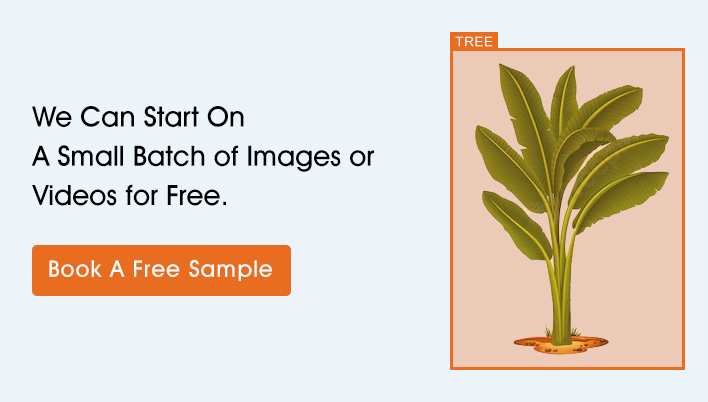
The Many Applications Of AI Image Annotation
Much like classic computers quickly became ubiquitous in society, so too has AI. It is getting integrated into every application that uses some form of computing. This expansion of use cases for AI has also expanded the need for annotation. It has found use in all major industries of the economy and is quickly grabbing space in others too.
Here’s how photo annotation affects the various sectors of the economy, directly or indirectly:
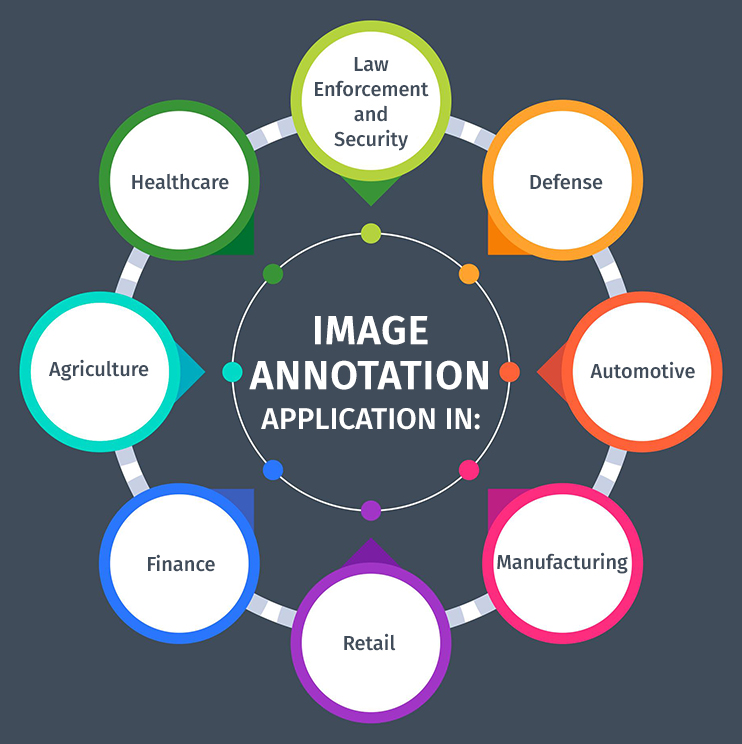
Law Enforcement and Security
The police have relied on various tools to catch criminals. One of their biggest assets in solving crime is images of suspects. The criminals are identified due to those images or sketches based on the description of the suspect’s face.
They also rely on a large database of past offenders to determine if someone’s a repeat offender or not. With AI-based face recognition, there’s no need to manually browse through the database. The recognition is more accurate and quicker. It can even happen in real-time.
Advanced research into this with AI image annotation is helping machines recognize offenders with even disguises or accessories on. They are also getting better at determining the faces from pictures like Photo ID. They’ve even gotten better at recognizing stolen vehicles with the additional data that modern vehicles provide.
Defense
Information about the surroundings plays a crucial role in combat situations. Soldiers on the ground and key decision-makers elsewhere rely on it to successfully conduct a campaign. There are varieties of terrain objects they must know about while searching for the enemy.
The enemy will be using camouflage techniques to conceal themselves and their weapons. Systems must peer through that to the best extent possible.
An image annotation service working for military applications must have a keen eye to spot such things. The AI used for these purposes has to distinguish between its own and the enemy’s vehicles. It is especially challenging when both are likely to sport the same camouflage.
It must also be able to recognize the firearms they are carrying to help gauge its firepower. It should help to accurately track their movements, even in low light conditions. The images could be in thermal and infrared too and taken from satellites with less-than-ideal resolution.
None of it is possible without the versatility and accuracy in target detection provided by image annotation. Vast amounts of data need to be fed to gain those qualities. It is why the US military earmarked 800 million USD in 2021 specifically for A.I. development activities.
That is in conjunction with Billions more for related R&D like autonomous vehicles and advanced robots development. All of those rely on accurate object detection provided by high-quality annotated data.
Automotive
The automotive sector is perhaps the one that has normalized A.I. object detection among the masses. It is all thanks to the development of autonomous or self-driving technology. Vehicles that drive with little to no input from a human require precise photo annotation to prevent collisions.
The roads and natural landscapes are very dynamic places, with quick-changing backgrounds and objects. The A.I. in the vehicle must accurately recognize objects present there. It must also gauge their speed and distance to assess their threat level with respect to the vehicle.

In-depth image annotation services are required to give these vehicles’ A.I. such accurate object-detection abilities. The detection may happen using onboard computing power or through connected servers.
The system must do it within fractions of a second. The speed of detection may mean the difference between safety and accident. Annotation is also necessary for accurate detection during bad weather conditions. The vehicle must work as expected even with rain, snow, or dust partially obstructing camera views and producing poor-quality data.
On top of that, the A.I. is expected to flag potential criminals that may be causing harm to the vehicle and/or its occupants. Here, AI image annotation must include facial detection and not just pedestrian detection.
Manufacturing
Manufacturing involves a plethora of operations that are increasingly undergoing automation. Many of these require accurate object detection by the production software. It needs to be able to distinguish between the different components of different products on the same assembly line.
The A.I. must know the difference between those components based on its identifiers like size, shape, color, serial number, etc. That way, it can pick what it needs and leave the rest for human workers. Such distinction also aids quality assessment. Systems that can accurately separate defective products save time and cost.
Image annotation is the key to realizing these abilities for the A.I. used in manufacturing. Training it to correctly recognize what it is viewing and take the correct course of action is crucial to seamless production.
Annotation can also extend the abilities of the AI to include other services. Factory owners are now dependent on AI for services like infrastructure inspection and inventory management. The A.I. must be trained to recognize faults in the various machinery used or the factory building itself.
Likewise, A.I. in inventory management should accurately read labels with bar and QR codes, determine box size, and estimated weight. An image annotation service can help with it all, possibly aiding automated restocking requirement alerts. It helps bring down the cost and speed up fixes of faulty equipment.
Sorting defective products early on also saves costs in terms of product returns. It makes the entire supply chain efficient. The push for zero-human, fully-automated factories is accelerating the use of annotation for improved AI performance.
Retail
The world of retail is a fast-evolving one, and it’s using A.I. to step into the future. On the one hand, there is the relentless growth of eCommerce. On the other is the modernization of the classic brick-and-mortar stores. Image annotation services have an important role to play in both instances.
eCommerce portals have a myriad of products with a vast array of attributes. They have images that display those products and attributes to a potential customer.
Annotated data for each such product image helps the A.I. to accurately display the searched product. It should correctly recognize the searched item across millions of similar products in a possibly global database.
Robotic arms and other automated warehouse assistance/factory production equipment rely on this correct distinction to function correctly. They can’t pick out the desired item otherwise.
Ai image annotation is also critical in the physical storefront scenario. Retailers are increasingly incorporating sophisticated AI software to enhance or transform the shopping experience.

An example is AI accurately detecting a person via facial recognition as they enter the store. It can then check their history to determine what they want to buy. It can then verify the stock of the product on the shelf via in-house cameras and send the customer notification of the same.
The message will contain all the information a customer could want about that product, including discounts. The same can be verified with inventory data. Any discrepancy can be brought to the supervisor’s attention.
With accurate photo annotation, the store’s AI can pick out bad quality perishable products from the good ones too. This will help save the brand’s reputation by helping them stock only good-quality ones.
The future of retail includes AI assistance with virtual trials of products by customers. There are already examples of retailers using AI-assisted displays to overlay an attire over a person. There’s even use of this technology in smartphones using apps.
In these cases, the AI must distinguish the different features of the person or object it is viewing. It must then overlay the product in the right position to bring out its best features.
Image annotation services are critical to achieving this. They can help the AI locate the subject and reject the background. This accurate recognition helps make the sale possible by marketing the product with the right appeal.
Finance
While there is currently extensive use of A.I. in finance. Industry players are finding more innovative ways to incorporate it into their services. This adoption may be directly or indirectly. The biggest use of annotation here is for financial security-oriented AI.
An example is a bank’s AI using an ATM camera to accurately identify the person using it. This capability may be used for additional customer verification purposes or criminal identification.
Image annotation also becomes necessary for fingerprint recognition. Smartphones today use fingerprint and facial scanning for verification of online purchases. Those scanners are also subject to dust, grime, sweat, etc., which can reduce the quality of the scan.
The A.I. should correctly determine the identity of the person despite these challenges. It is only possible with high-quality annotated visual data. This also applies to the recognition of checks, invoices, and receipts.
Scanned copies of the same may not turn out in the best shape. It is up to the AI to be able to correctly glean the vital information for such copies. A professional image annotation service is needed to train such A.I. to develop high levels of accuracy.
Agriculture
Industrialized agriculture heralded a revolution in how humanity produced its food. Better tilling and sowing techniques, improved irrigation methods, genetically-modified crops, and a host of other practices are producing large yields. The modern-day technological revolution is taking this to new heights, sometimes literally.

A.I. is quickly becoming a vital component of agriculture-assisting equipment. Associated personnel, from farmers to satellite operators, use A.I. in various capacities to improve agricultural yields sustainably. Ground and sky-based images are key components of this practice.
AI image annotation is used to mark the different types of plants, their condition, the soil condition, weather pattern and prediction, agriculture equipment and their status, and a whole lot more. The presence of pests can be identified before they can harm crops.
Newer practices like autonomous seed planting and crop harvesting are also possible with AI. For that, it must identify the correct seed planting spots and plant conditions respectively via images.
Animal husbandry is also ripe for this transformation. Detecting empty feed bowls for automated refilling, identifying anomalous movement patterns for early disease diagnosis, etc., are where AI finds its use. Accurate photo annotation enables the AI to recognize these events and perform the appropriate action.
Similarly, reforestation and conservation efforts are also getting a boost thanks to such AI. Many of the agricultural AI’s features can be used in a modified manner to regrow forests. Annotation helps the system correlate GPS and on-ground image data for accurate boundary determination.
The annotation also helps it recognize the correct seed to plant in the right spot to maintain the plant diversity crucial to a forest. It can also help conservation efforts with accurate counts via camera trap images of animals.
Thus, image annotation has an expansive and important role to play in the field of agriculture and forestry.
Healthcare
Timely action from medical professionals is what it takes to save a person from the brink. And a quick diagnosis is what makes that timely action possible. The fast response times and high accuracy of computers have been a boon to the healthcare industry.
The use of advanced AI is healing the problems the industry has long faced. There’s use for it in both treatment and administration. It can near-instantly diagnose health conditions with a fair level of accuracy. It can act as the doctor’s or technician’s assistant, or in some cases, provide the report itself.
The latter feature is still being worked on by image annotation services. It requires a very high degree of accuracy to not misdiagnose. So, many more annotated images need to be used before the system becomes completely reliable.
The push for greater AI use in healthcare is coming from the increasing use of telemedicine. (Telemedicine is the practice of remotely providing healthcare services. The internet is used to connect the doctor and patient when they can’t be in the same location).
Telemedicine takes many forms, and A.I. is quickly taking the center stage. Remote surgeries performed using robotic limbs require that an A.I. help with their control. A.I. image annotation aids the system in analyzing the camera feed.
Understanding the problem and the operation being performed helps assist the surgeon(s) and staff better. Factors like the depth of incision made, the blood flow rate through the vein, etc., can be conveyed by overlaying them on the doctors’ feed.
Correctly annotated images also enable the A.I. to better read data from real-time tests. The readings can then be collectively analyzed to give a complete picture of the patient’s health.
The goal here is to make the A.I. a reliable diagnosis and medical intervention tool. Photo annotation enables it to have such accuracy by scanning labeled photos of health issues by the millions. If it can reach a point where it can detect a disease in the earliest stages, many more lives can be saved.
On a related note, the rise of eCommerce for medical purposes is also using annotated data. Telemedicine also requires that medication be delivered to remote locations in time. Pharmacies are using autonomous vehicles for it, including drones.
These autonomous vehicles must navigate often difficult terrain and weather conditions to deliver critical medications in time. Drones especially have a limited operating time, so every second counts for them. An image annotation service is needed to train the A.I. controlling them for successful operation.
The drones, for example, must identify an alternate dropzone for the package in case the original isn’t feasible. That task needs accurate and quick image processing of the terrain around it to accomplish. Otherwise, the delivery will fail and jeopardize the treatment.
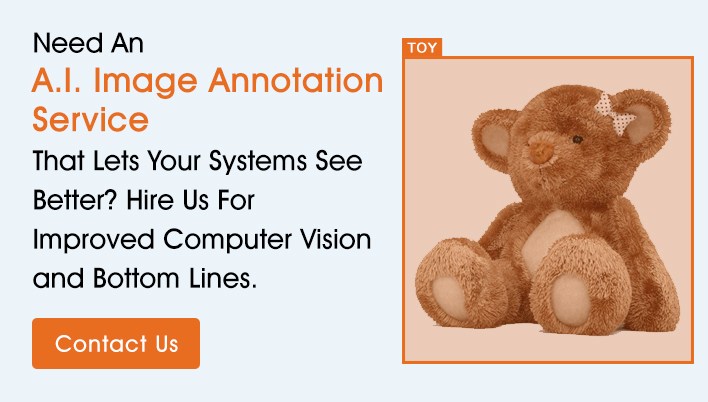
The Various Types Of Image Annotation
There is demand for versatile A.I. models that can go beyond their intended purpose. For that, the A.I. should be able to accurately identify every object in its field of vision. For applications where a limited focus is demanded, it must use that identification to accurately reject the same.
The use of image annotation for the development of such A.I. models will need to be varied accordingly. There is no one-size-fits-all solution with annotation; it’s always a trade-off between effort and accuracy. The available processing power and budget also come into play.
Neural network components are costlier and have less processing power than their legacy counterparts. It’s still early days for the advanced versions of the technology. All of these factors must be considered while creating the A.I. model of choice.
In practice, three types of annotations have gained ground among developers. They each have their advantages and disadvantages. The application will predominantly decide the type the image annotation service will select. What’s common between them all is that higher-quality images will yield better results.

Classification
It is the simplest and quickest type of annotation there is. This is because it is straightforward in its approach, focussing only on the image to be identified. It only applies a single tag to an image with the intent to recognize the entire image with it.
It works very well for instances where the A.I. needs to capture abstract information. It is designed to detect similar objects in images of a data set.
The objects in the images are assigned into classes based on their features and other attributes. With classification photo annotation, the A.I. will be able to identify the presence of a specified object in an image and name its class. It’s also helpful in training where an unlabeled image with similar classes to familiar ones is used.
An example of this type of annotation is the identification of a bar code sticker amidst others. Annotators supply the system with labeled images of barcodes. The images will also contain stickers of different types. Here, the class is the barcode, and images of stickers are the input.
Over time, the A.I. will be able to distinguish between barcodes and other stickers. And it will be able to do so with unlabelled images scanned in real-time. This distinction ability established by an image annotation service will aid in better inventory management.
Object Detection and Recognition
This type of annotation can be considered an evolution of the classification type. Here, additional information gets considered on top of simple class labeling. The additional information will relate to an object’s location and quantity in an image.
The extra task that annotators have here is the requirement of boundary addition. To define an object’s presence, location, and quantity, the model must be able to distinguish it from the background. With object boundaries, the model can separate the two in an image.
Thus, in this type of A.I. image annotation, different classes get detected in a single image. This is in contrast to the previous type where an entire image gets considered as a class.
Polygons of various shapes are used for the annotation process. Objects are surrounded by polygons that fit them best. Drawing a Bounding Box around them is the other method commonly deployed.
The box could be either 2D or 3D depending on the requirement. Lines and splines are also drawn around objects in a free-hand style. They help separate key boundary regions, particularly for oddly-shaped objects like trees.
The use of such object-engulfing methods makes location identification and tracking easier. The image annotation boxes or polygons can each have unique identifiers for recognition such as names or numbers. The object’s color too can constitute an identifier in case there’s no chance of multiple occurrences of it.
An example of this type is vehicle detection and tracking. The A.I. must continuously identify a particular vehicle amidst others. It must also be able to tell if it’s stopped or moving. Besides that, it should be capable of tracking it once it is on the move. It should be able to detect an anomaly if it sees a deviation of attributes from the norm.
Segmentation
Here, image annotation services get very picky, dividing an image into multiple segments. The objects and boundaries are then labeled in those segments. The annotation here happens at the pixel level, with each pixel getting attached to a class or object. This type of annotation has the maximum accuracy level. At the same time, it is also the most difficult to perform.
It is also the only type of annotation that has sub-categories within it. The three types are:
- Semantic Segmentation
Semantic segmentation is used to distinguish between similar objects by depicting boundaries between them. This photo annotation type produces highly precise results with respect to an object’s features like its existence, shape, size, etc. Thus, it makes it easy to demarcate individual objects of similar type in an image.
- Instance Segmentation
It is used to identify the presence of objects within an image, along with their location too. Other attributes like size, shape, and number can also get included. This sub-type of segmentation is most useful for confirming the presence of an object within an image and labeling it. It also finds use in filtering out unwanted objects within the image.
- Panoptic Segmentation
This sub-type of A.I. image annotation is the hybrid of semantic and instance segmentation. It gives the system the ability to label both the background and objects within an image. Thus, it brings the best of both worlds to the table.
Boundary Identification
This rather unique type of annotation may be used separately or in conjunction with the others mentioned above. When used independently, it helps identify the boundary of any object. This is useful when there’s a need to train A.I. models to solely recognize lines and curves.
An example of a use case is for training a mathematical A.I. model. Here, the A.I. will need to recognize points, lines, and polygons. In the case of lines and points, they are their boundaries. Thus, a boundary image annotation service is needed to help the A.I. recognize these accurately.
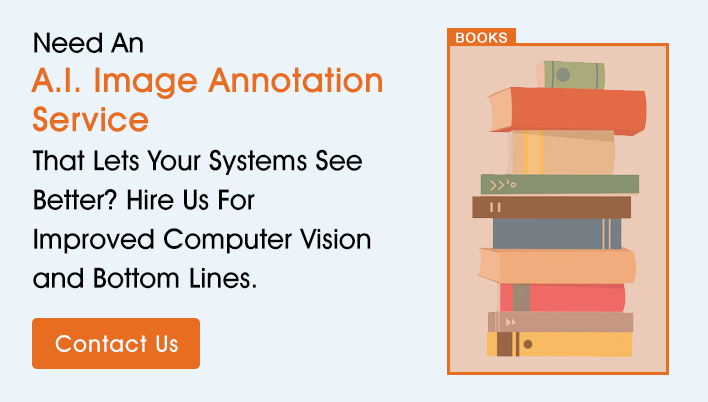
Get The Best Computer Vision Results With Outsourced Image Annotation Services
The concept of objects behaving similar to humans has always fascinated humanity. Attempts at automation throughout history have resulted in today’s A.I. technologies. Now, machines can not only replicate human movement but intelligence as well. While they are very far away from human-level cognition, the progress made thus far is already changing the world.
Entire industries are transforming as a result of incorporating A.I. And further development is only making its adoption for business inevitable. Image annotation is one process that is at the heart of taking A.I. into the future. It is what makes computer vision a reality, helping A.I. models make sense of the world around them visually.
If you have annotation requirements that demand supreme accuracy and speed, then SunTec A.I. should be your outsourcing partner. Our experience and expertise in the field will result in your A.I./ML models reaching their full potential.
We provide the most personalized image annotation services to businesses across industries. Our Deep learning model training covers the entire pipeline, from data gathering to testing. We’ve provided our annotation services to a plethora of top industry players across verticals.
SunTec A.I. will handle your every image annotation service requirement regardless of scale and schedule. With experts around the world, you needn’t have to worry about time zones impeding the progress of your project.
Our experts are handpicked to deliver the best services with absolute accuracy. And we use the latest in related tools to accomplish our tasks.
Thus, by outsourcing your annotation requirements to us, you’ll have the best Computer Vision experience from your A.I. model. We also provide Chatbot Training and Text Annotation services. And you’ll get it all within your budget for improved ROI.
Visit our blog section to learn more about us. Get a free sample of your annotation project done by filling in the details on our Contact Us page. You can also email us at info@suntec.ai or call on +1 585 283 0055 (US) / +44 203 514 2601 (UK).